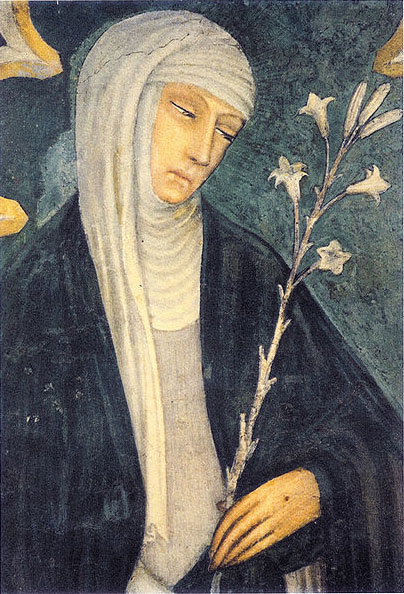Catherine of Siena
A genius of religious wisdom, the illiterate Catherine of Siena demonstrated that love, and therefore light, are given to everyone, no matter their skill level or education. Catherine’s example opens a window of understanding onto the mystery of Mary of Nazareth. If one wants to know God in order to love him, they already know him , precisely because of their love for him. Through love, through life, a child knows who their father is even if they aren’t conscious of the work he does in the world, the position he holds, or his personality traits. “Everyone who loves is begotten by God and knows God. Whoever is without love does not know God, for God is love.” (1 Jn 4, 7 – 8).
Catherine of Siena concentrates Jesus’s works and words into two principal realities: Fire and blood. As is written in Revelations (1,5), Jesus is “him who loves us and has freed us from our sins by his blood”. And, it is the fire of love that brings about redemption: “I have come to set the earth on fire, and how I wish it were already blazing!” (Lc. 12, 49).
If a christian community or a single soul remains frozen within their own structures and ways of doing things, even if beautiful and holy, but no longer spreading the fire of charity, then they become like cold embers. “For our God is a consuming fire…” (Heb. 12, 29). From the time of Golgotha to today, a burning revolution of love has consumed errors, judgements, and crimes: it destroyed putrid waste, souls that were ruined, and suffocating establishments; it incinerated the corpses of the Dead.
For every person born by a woman, it is right and just that holiness be brought into homes and onto the streets. This truth, Catherine repeated again and again to her followers, gives wings to the masses. The Church, growing in its universal consciousness especially now, after the (Vatican) Council, wants to see frustration replaced by joy-filled coexistence.
Catherine concentrates the vitality of the redemption into two realities: fire and blood. As fire, it destroys; as blood, it gives life. This is precisely what the mystics reveal to us: In giving all of themselves to the point of losing everything, even their own strength, they are consumed by fire. Blood circulates in living beings and gives life: Christ’s blood (and that of Christians) nourishes the mystical body.
Igino Giordani, The One Love
Hearts that truly love, are rooted in joy.
“Charity”, says Saint Catherine, “does not search for things of its own nor does it try to find itself or God as an end in itself, but rather one’s self and one’s neighbor for God, and God for Himself.
This means that a Christian soul does not love for its own benefit, for its own glory. A soul should not love one’s neighbor nor God out of self-interest. He or she needs to love God and one’s neighbors out of love for Him.
Thus, love that is centered in what is Eternal does not experience ups and downs or disappointments; it acquires serenity and is without fear, with the peace of God himself. Charity, continues Catherine of Siena, “does not look for itself, because it does not choose places or times of its own accord, but according to what divine Goodness reveals to it. Every place is the right place, and every time is the right time. Tribulations and consolations are of equal value, because the soul searches for God’s glory through the salvation of souls.”
By killing not our bodies but “our own spiritual and earthly will” or, as the Saint says, by burning self-love in charity, the soul becomes joined to God: it becomes God, paying to become His will. It does not even search for conditions in life that are more perfect, more religious, more ascetic, or in other places or regions. Rather, it does well right where it is, if that is where God wants it. “Take this cup away from me, but not what I will but what you will.”
Mythology presents to us the figure of the great warrior, Antaeus. Each time he touched the ground, he would regain his strength.
And theology, too, teaches us something similar. Touching the depth of desolation with Christ, a Christian touches the apex of consolation. He, Christ, descended to Hell in order to rise to Paradise. On the cross, when the weight of his exhausted body caused the nails to lacerate his wrists, provoking the most atrocious muscle spasms, and when lightning lit up the heavens and tremors rocked the earth, He cried his abandonment. He journeyed the road of desolation and agony; but then immediately afterwards his soul rose again to the Father, abandoning himself to Him exactly in that moment when he felt most abandoned by him: “Into your hands I commend my spirit…..”
Saint Catherine helps make visible to us two things when there is perfect charity: first, patience in the face of small or big insults and injustices; and concrete love at the service of one’s neighbors.
If these two characteristics are lacking, then it means that a soul is, instead, full of love for one’s self: and thus “full of anger, lacking in patience, and a sower of seeds of hatred towards God and one’s neighbor”. The soul, is abandoned in a seeming vortex of human fragility, without peace.
Saint Catherine shows us the way by which we can return God’s love, of which we are much in need. This way is : our neighbor.
This is the linkage: God – Myself – My Neighbor. Through charity, I can be mediator between God and my brother or sister: a switch igniting Christ, a bridge connecting two far away points and thus fulfilling the work of redemption by the one and only mediator, Christ. In this way He accomplishes his task in the Mystical Body.
Likewise, at times, my neighbor is there to reconnect me to God: this neighbor, like each one that has been redeemed, becomes a mediator out of love, God’s life in him or her: A continuation of the redemption.
Igino Giordani, Our Neighbor




